|
The sixth of June was
a Monday, and I still wasn't back at work. Thankfully, my infected
surgical incision had healed enough that I no longer had an open
wound, and, aside from when I did extreme twisting of my body,
I was feeling fit as a fiddle. In the early afternoon I headed
out to the train yard and took a few photos.
This one shows some
graffiti by an artist who was aware enough to not obscure the
road number and load information on the side of the train, and
to repaint the numbers which he had gotten some paint on. He even
sort-of tucked the first '9' and last '5' behind his 'I' and 'K'.
Awful kind for someone who's painting on other folks' stuff.
|
|
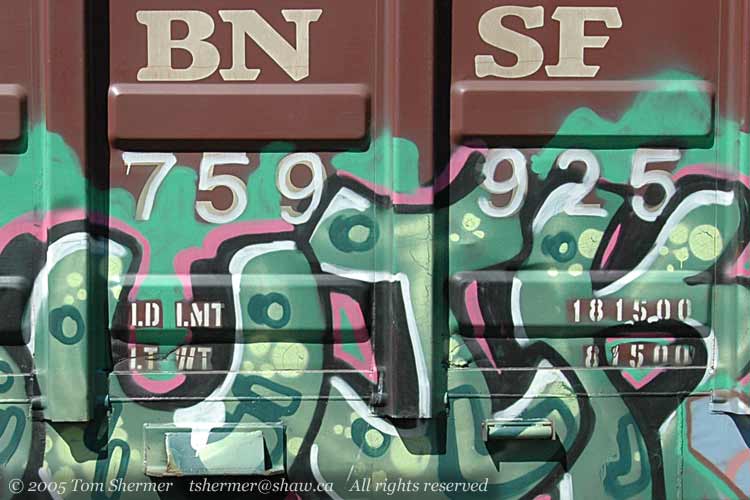 |
|
Maybe he thought that
BNSF would leave his design longer if they didn't have to paint
their own information back on. Maybe it works.
Also in the rail yard
was a recently fumigated boxcar. These come by every now and then.
That phosphine gas isn't something that I'd want to mess with.
|
|
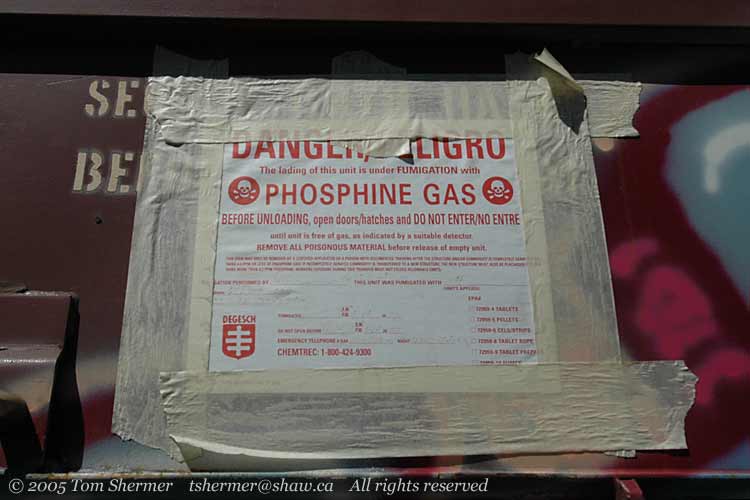 |
| The following
piece of graffiti was a bit of a shocking sight to me. "Lowepro"
is a line of photography accessories, and it's very odd to see it
scrawled on the side of a coil steel car. Maybe someone whose last
name is Lowe saw some Lowepro equipment and borrowed the moniker.
I prefer that possibility to the one of a photographer turning to
the dark side. |
|
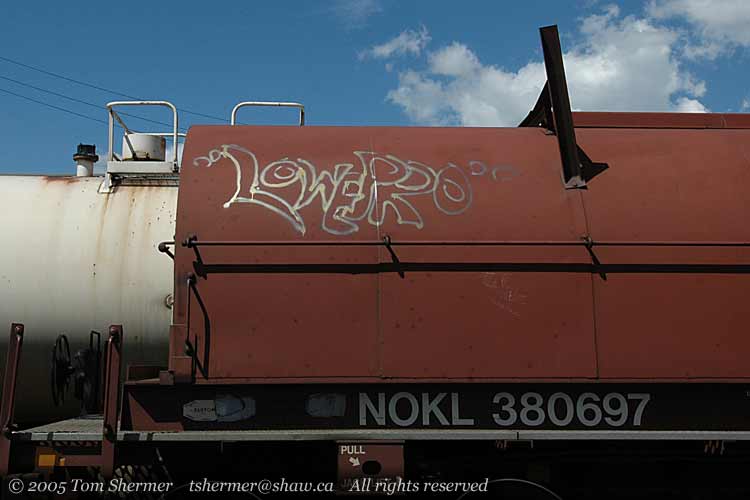 |
|
Rail cars are identified
by a road number, which consists of a two- to four-letter
reporting mark and a car number. The above car
has the road number NOKL 380697. The reporting mark indicates
the company that owns the car; the mark NOKL is for the Northwestern
Oklahoma Railroad.
For the following photo,
I put my wide-angle lens on the camera and caught a good bunch
of sky along with the rail car. That car is a covered gondola,
owned by CIT Group/Capital Finance (CEFX).
|
|
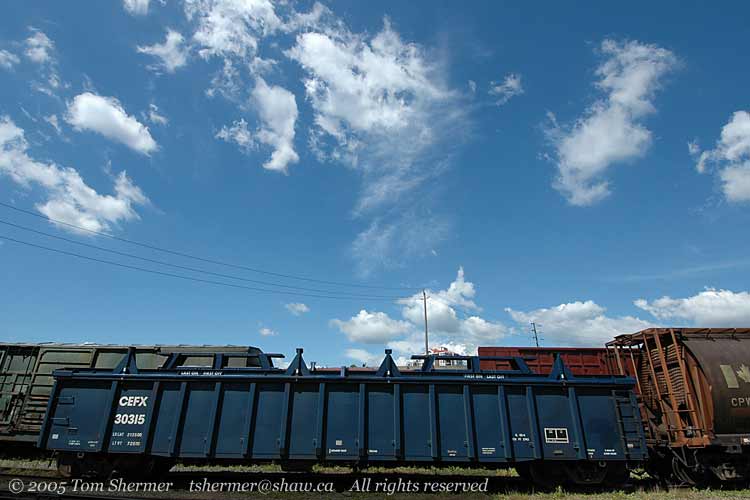 |
| The train
yard was fun, but it wasn't enough for me, and I decided to head
out to a park. I chose to go to Tynehead Park in Surrey, just because
I hadn't been there in a while. When I arrived, I found a Snowshoe
Hare munching on some grass near some picnic tables. In order to
get this shot, I laid down on the grass myself. |
|
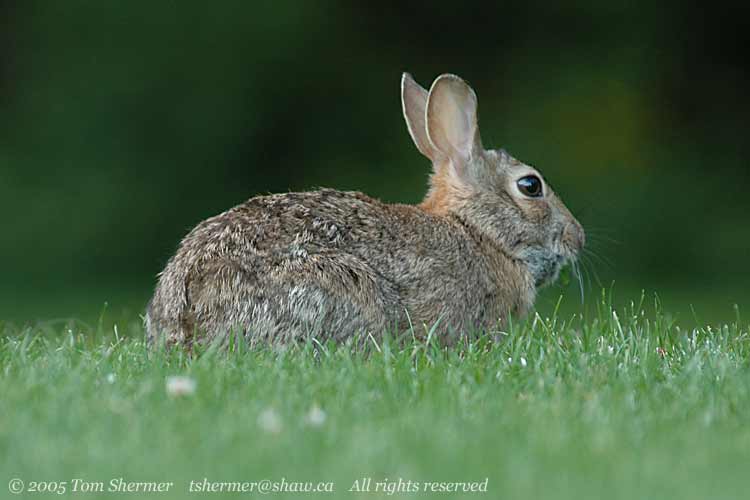 |
|
I was able to do that,
and to get back up, without any real abdominal pain, so I felt
like I was truly getting better.
I wandered around on
some trails through the woods for a while, but found little that
was worth photographing and not much light to photograph with.
So I headed to a more open part in the eastern part of the park.
I was chasing an unidentified bird through a meadow when I noticed
some orange in a tree above me. There was a Black-headed Grosbeak,
just sittin' there. He posed for me for quite some time.
|
|
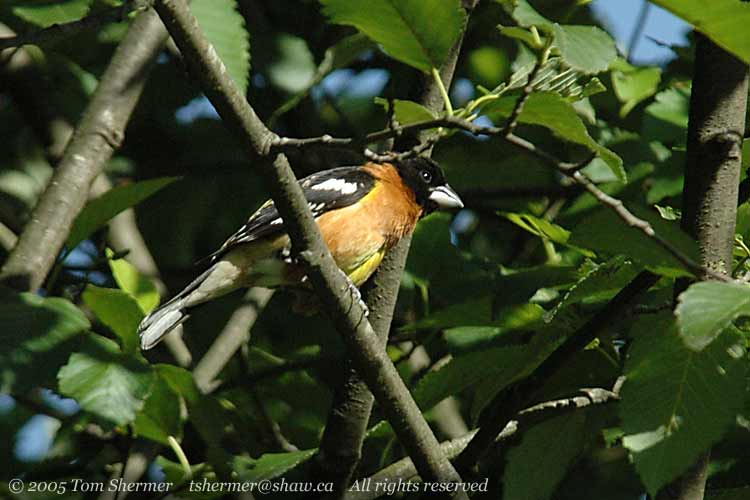 |
| There were
a few American Goldfinches flitting from tree to tree in the same
area. Here I caught a male posing near the grosbeak. |
|
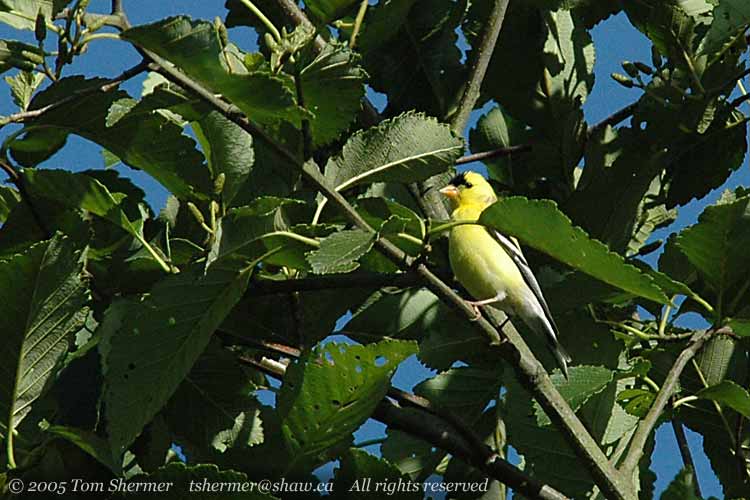 |
| I watched
some swallows chasing each other around the meadow and then eventually
made my way further down the trail. On a thin line of trees separting
a couple of fields, I found this Empidonax flycatcher, which
I think is a Willow Flycatcher. |
|
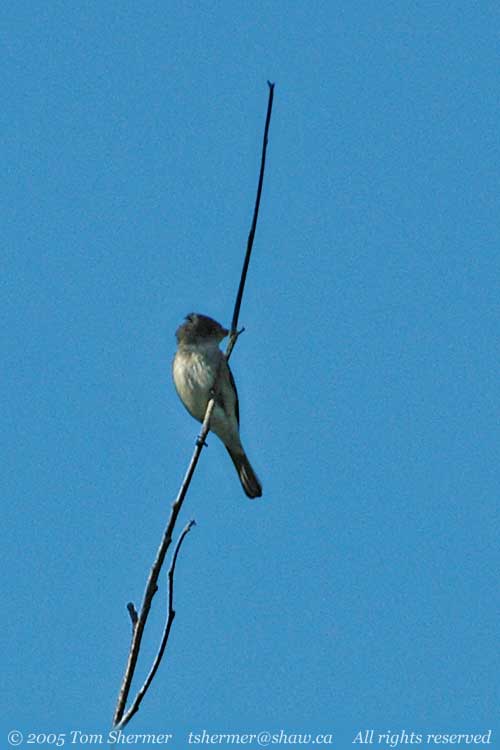 |
|
I never got his face
in good light, though.
There were also a few
Cedar Waxwings around. I had recently gotten a few books on bird
behaviour, and had been reading about Cedar Waxwings and some
of their courtship behaviour. I was hoping to see some of it,
but it was probably too late in the season for courtship. Anyhow,
I did get some photos of them; here's one in the sun and one in
the shade.
|
|
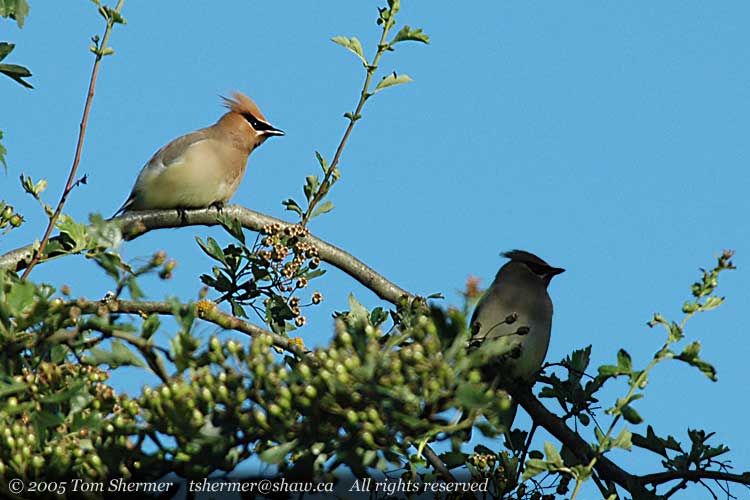 |
| The sun
was getting low enough that only the very tops of the trees by me
had sunlight on them; I was east of a patch of pretty tall trees
and the sun was setting behind them. I headed back towards the car,
but stopped when I noticed some slugs on the path. The interesting
thing about these slugs was the orange fringe around their bottom,
which I couldn't recall ever having seen before. |
|
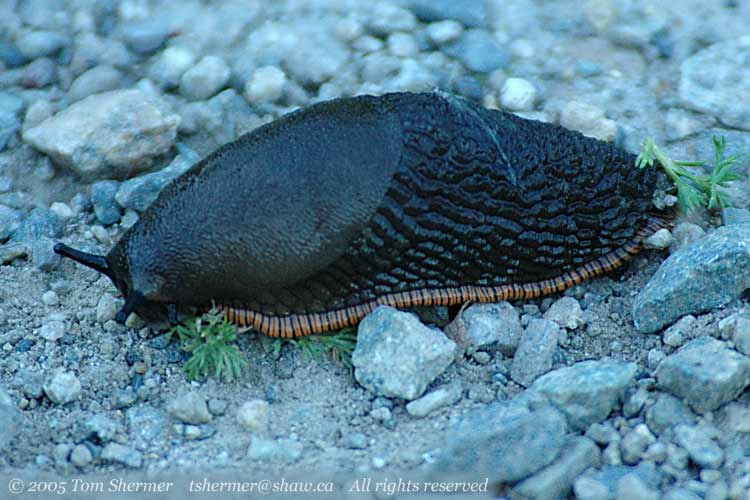 |
|
I recently acquired
a very nice pulmonate book for my area (Land Snails of British
Columbia, by Robert G. Forsyth) put out by the Royal BC Museum.
It leads me to conclude that my slug is a Chocolate Arion, or,
as Linnaeus called it, Arion rufus. (He also called it
Limax rufus, but that's another story.) Choco-arions can
grow to about 180mm long; this one was around 100. (100mm is a
very easy measurement; it is about the distance across my hand
including my thumb.)
I made it back to my
car a little before 6:00 and drove back towards home, taking the
road through Surrey and then the Patullo bridge rather than risking
the highway and the Port Mann nightmare. When I got to New Westminster,
I saw that they had the demolition of the old St. Mary's Hospital
well underway. The sunlight and shadow falling on it made it a
shining white-and-grey beacon just yearning to be photographed.
So I stopped my car
and went about my artistic duty. Here's a shot of some detail
on the half-demolished roof.
|
|
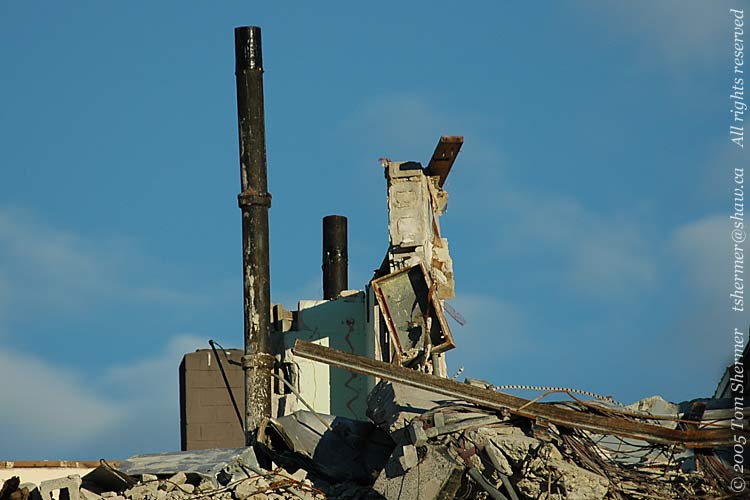 |
| On this
one, I've not zoomed in near as much, and you can start to get a
sense of the structure's vertical development. |
|
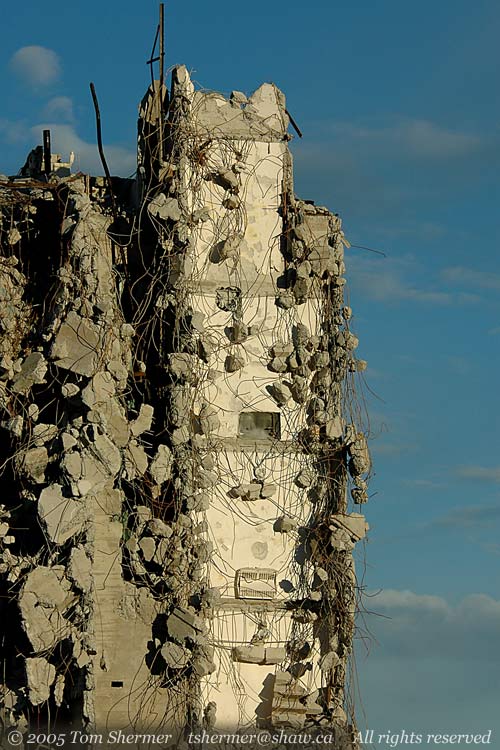 |
|
The next one is further
out still. Here you can see where the first photo fits (in the
middle of the roof) and where the second one is, too. The first
two photos were taken with the long (80-400mm) telephoto, and
this one with the midrange (24-120mm). This photo somehow reminds
me of a castle jutting into the air, with the white shaft to the
right being a tower that is one of the castle's corners. This
one shows the delicious light and shadow, too.
|
|
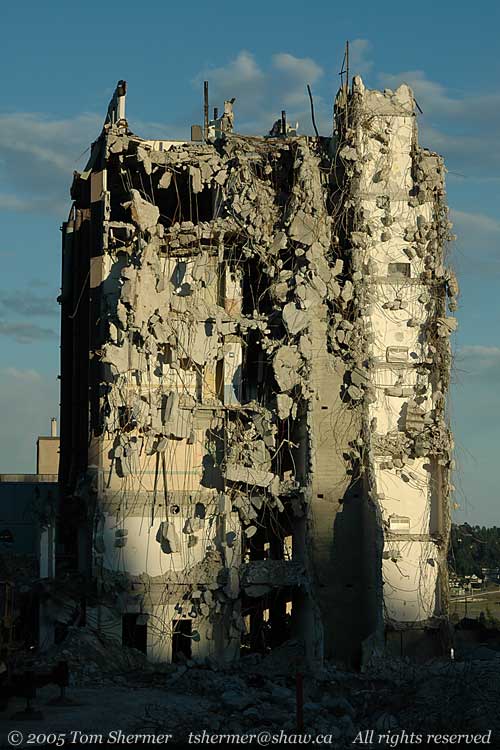 |
| Back down
on earth, I got a photo of the wrecking ball they were using in
the demolition. The crane is a Lorain Moto-Crane of some sort. It's
got five axles, so it's not one of the smaller models. |
|
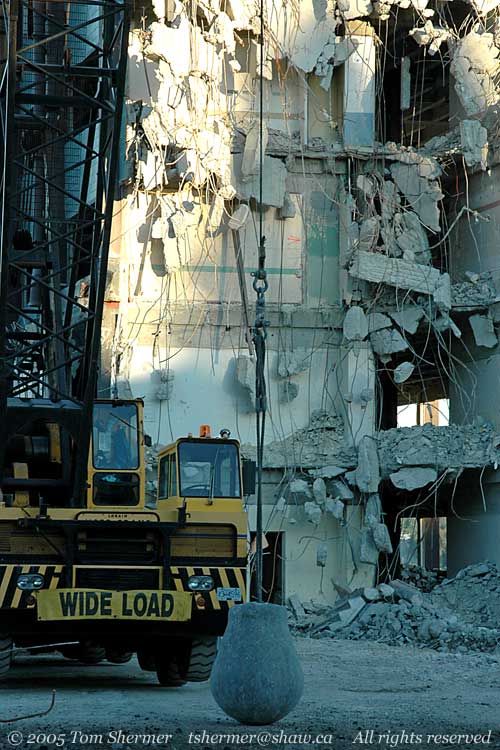 |
|
Lorain was bought by
the conglomerate Terex, whose main business seems to be buying
up heavy equipment manufacturers. They made some cranes under
the Terex/Lorain label, and then retired the Lorain name.
Well, I finally pulled
out my wide-angle and here you can see that it's really earning
its keep: It got the whole danged crane into a horizontal photo,
and made the building look really small by comparison. The crane
boom does not actually reach three times as high as the building.
|
|
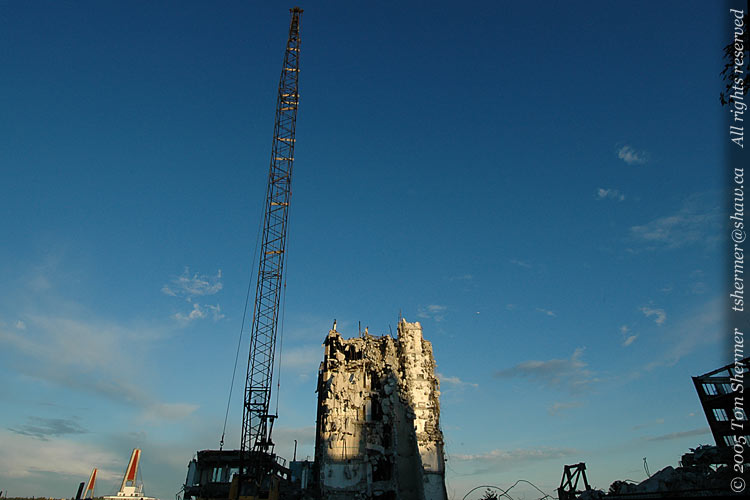 |
| And here
I used the wide-angle to get more of the whole site into the photo,
and you can see that there were actually two structures being demolished.
|
|
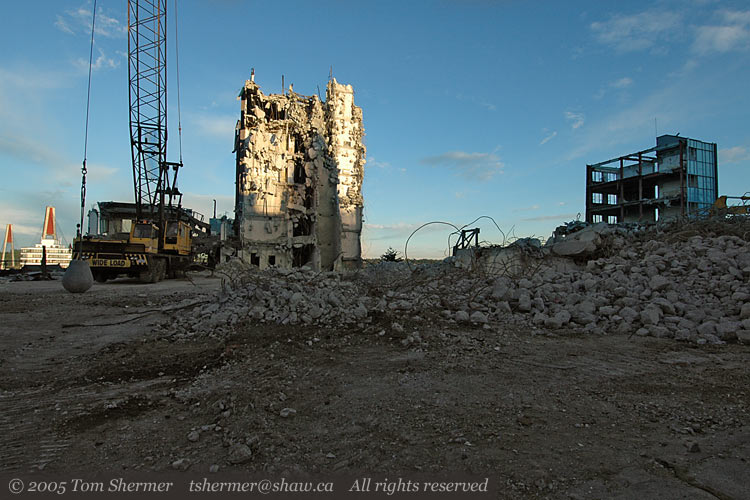 |
|
They had a few other
heavy machines on the site—a Deere 450C LC, comparable to
a Cat 345C, and a smaller Hitachi excavator, which I couldn't
identify. They were both in shadow and I didn't get any good photos
of them.
But I was happy with
the shots of the building being torn down, and the novelty of
shooting at three very different types of sites in the same day.
I headed home and spent the rest of the day checking my photos
and working on the photojournal.
Wondering what Chocolate
Arions taste like,
Tom
|
|